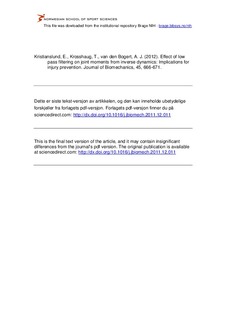Effect of low pass filtering on joint moments from inverse dynamics: implications for injury prevention
Journal article, Peer reviewed
Permanent lenke
http://hdl.handle.net/11250/170926Utgivelsesdato
2012-02Metadata
Vis full innførselSamlinger
- Artikler / Articles [2119]
Originalversjon
Journal of Biomechanics. 2012, 45(4), 666-671Sammendrag
Analyses of joint moments are important in the study of human motion, and are crucial for our understanding of e.g. how and why ACL injuries occur. Such analyses may be affected by artifacts due to inconsistencies in the equations of motion when force and movement data are filtered with different cut-off frequencies. The purpose of this study was to quantify the effect of these artifacts, and compare joint moments calculated with the same or different cut-off frequency for the filtering of force and movement data. 123 elite handball players performed sidestep cutting while the movement was recorded by eight 240 Hz cameras and the ground reaction forces were recorded by a 960 Hz force plate. Knee and hip joint moments were calculated through inverse dynamics, with four different combinations of cut-off frequencies for signal filtering: movement 10 Hz, force 10 Hz, (10–10); movement 15 Hz, force 15 Hz; movement 10 Hz, force 50 Hz (10–50); movement 15 Hz, force 50 Hz. The results revealed significant differences, especially between conditions with different filtering of force and movement. Mean (SD) peak knee abduction moment for the 10–10 and 10–50 condition were 1.27 (0.53) and 1.64 (0.68) Nm/kg, respectively. Ranking of players based on knee abduction moments were affected by filtering condition. Out of 20 players with peak knee abduction moment higher than mean+1 SD with the 10–50 condition, only 11 were still above mean+1 SD when the 10–10 condition was applied. Hip moments were very sensitive to filtering cut-off. Mean (SD) peak hip flexion moment was 3.64 (0.75) and 5.92 (1.80) under the 10–10 and 10–50 conditions, respectively. Based on these findings, force and movement data should be processed with the same filter. Conclusions from previous inverse dynamics studies, where this was not the case, should be treated with caution.
Beskrivelse
I Brage finner du siste tekst-versjon av artikkelen, og den kan inneholde ubetydelige forskjeller fra forlagets pdf-versjon. Forlagets pdf-versjon finner du på www.sciencedirect.com: http://dx.doi.org/10.1016/j.jbiomech.2011.12.011 / In Brage you'll find the final text version of the article, and it may contain insignificant differences from the journal's pdf version. The original publication is available at www.sciencedirect.com: http://dx.doi.org/10.1016/j.jbiomech.2011.12.011
